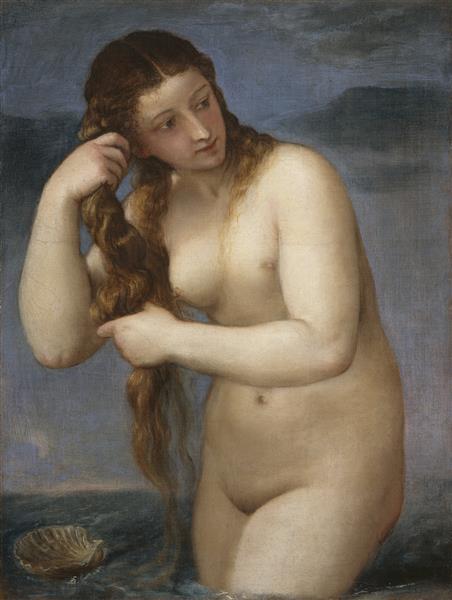Description
Titian's "Venus Anadiomene", created around 1520, is one of the most iconic compositions of the Venetian Renaissance, a period characterized by its rich color palette and mastery in the representation of the human figure. This canvas captures the mythological moment when Venus emerges from the sea, a representation that evokes both the idealized beauty and the sensuality inherent to the goddess of love.
In the centre of the painting, Venus is presented in an attitude of modesty, covering her anatomy with a delicate hand, while the movement of her hair and the foam of the water create a sense of dynamism, suggesting the strength of the sea from which she emerges. The figure of Venus is robust and voluptuous, faithful to the ideals of beauty of the time, where the curvature of the female body was celebrated as a symbol of fertility and sensuality. The luminosity of her skin, bathed in light, contrasts with the darker and deeper tones of the water, highlighting the freshness and purity of the goddess.
Titian demonstrates a masterful command of colour, employing a palette that oscillates between deep blue hues and warm golds that adorn Venus’ skin. This use of colour not only serves to bring the central figure to life, but also establishes an effective dialogue between the background and the elements surrounding the goddess. The texture of the water, treated with loose brushstrokes, contrasts with the meticulous smoothness of Venus’ body, a technique that Titian perfected throughout his career. This treatment of colour and texture is characteristic of his style, which moves away from the minute detail of Gothic art and embraces a more emotional and sensorial representation.
The background of the painting suggests a seascape, where the horizon is blurred in a soft mist, lending a sense of immensity to the painting. This compositional device not only frames the central figure of Venus, but also envelops her in a dreamlike atmosphere that invites the viewer to contemplate the union between the divine and the natural. Although there are no other visible figures in the painting, the implication of the presence of marine deities or even a distant viewer is suggested through the significance of the surroundings. This focus on the isolated figure in a vast landscape resonates in other works by Titian, where the focus falls on the individual against the immensity of the world.
“Venus Anadiomene” is therefore a work that goes beyond the mere representation of the female body; it becomes a symbol of eternal beauty and nature. Titian may have been inspired by earlier works by artists such as Sandro Botticelli, who also made an iconic representation of Venus, but he does so with an innovative approach that highlights his unique technique and vision. The sensuality of the figure, combined with the subtlety in the manipulation of color and light, gives this work a special status in the canon of Renaissance art and it continues to attract contemporary attention, evidencing the perenniality of its appeal and the relevance of the themes that Titian chose to explore.
KUADROS ©, a famous painting on your wall.
Hand-made oil painting reproductions, with the quality of professional artists and the distinctive seal of KUADROS ©.
Painting reproduction service with satisfaction guarantee. If you are not completely satisfied with the replica of your painting, we will refund 100% of your money.

